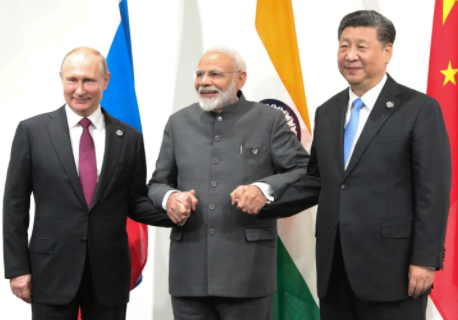Foreign secretary Harsh Shringla’s forthcoming visit to Moscow is a good occasion to examine the relevance of Indo-Russian ties in a world of changing geopolitical equations, greatly accelerated by the Covid-19 pandemic. The year 2020 saw several trends that impacted both India and Russia — the sharpening rivalry between United States (US) and China, the India-China border tussle, the continuing decline in ties between the West and Russia, and the change of guard in Washington.
No issue affected the Indo-Russian relationship as much as the border tensions between India and China. The Chinese aggression, in April/May 2020, in the border areas of eastern Ladakh, brought India-China relations to an inflexion point, but also demonstrated that Russia is capable of contributing to defusing tensions with China. On the other hand, Russia’s seeming equivocation initially diminished its standing among the Indian public.
However, that changed after the first bilateral high-level political contacts between India and China took place in Moscow on the sidelines of a September meeting of the Shanghai Cooperation Organization. The Indian defence minister, Rajnath Singh, and external affairs minister, S Jaishankar, met their Chinese counterparts on September 5 and 10 respectively. Earlier in June, Singh had visited Moscow to attend the Victory Day Parade. During the visit, he met Russian defence minister Sergey Shoigu and other officials. The Russians promised to positively look at India’s requests for expedited arms deliveries in view of the border conflict, despite some informal appeals against it by the Chinese.
The developments of 2020, preceded by the immensely successful Prime Minister Narendra Modi-President Vladimir Putin Sochi meeting in May 2018 and the pathbreaking Vladivostok summit in September 2019, may give the impression that Indo-Russian ties can be now put into cruise mode, having overcome the earlier hiatus. However, some ongoing geopolitical trends suggest that such a conclusion is premature.
The inflexion point reached by India in its relations with China has driven New Delhi to shed “past hesitations” and actively pursue more hard-nosed policies to protect its perceived national interests. This has included the pursuit of a closer relationship with the US; a determined restart to the Quad process — a coming together of India, Japan, Australia and the US; a clearer enunciation of “a free and inclusive” Indo-Pacific; an energetic neighbourhood policy; as well as intensified outreach to east and west Asia.
Russia, for its part, has, since 2014, faced deteriorating ties with the US-led West following the Ukraine crisis, exacerbated now by the Western reaction to the poisoning and post-recovery jailing of anti-government political activist Alexey Navalny.
Russia responded to these efforts to isolate it, by revving up its own “Pivot to the East”, the most distinct results of which are markedly improved relations with China, and better ties with Turkey (despite a brief hiccup), Iran and Pakistan. Russia, also, has officially been cold towards the concept of the Indo-Pacific, seeing it as a design to contain China. It is important to note, however, that Russia repeatedly reiterates that it does not see itself as anybody’s junior partner.
These trends combined with bilateral economic ties well below their potential, and possible differences developing over the “new friends” of the two countries, would suggest that India-Russia relations are likely to face some turbulence ahead.
If recent steps by India are an indication, then it appears that policymakers are aware of the pitfalls and are taking steps to intensify contacts and diversify areas of cooperation with Russia. Apart from traditional areas of cooperation such as weapons, hydrocarbons, nuclear energy and diamonds, new sectors of economic engagement are likely to emerge — mining, agro-industrial, and high technology, including robotics, nanotech and biotech. India’s footprint in the Russian Far East and in the Arctic is set to expand. Connectivity projects may get a boost too.
India and Russia are working to close the gap on Afghanistan and are calling for early finalisation of the Comprehensive Convention on International Terrorism. Additionally, Russia supports India’s candidacy for permanent membership of a reformed United Nations Security Council and of the Nuclear Suppliers Group. India and Russia also plan to intensify cooperation on regional and global issues within the framework of the Eurasian Economic Union, Brazil, Russia, India, China, South Africa, SCO, Russia, India, China, and G20. India should pursue and facilitate Russia’s engagement in the Indo-Pacific. Russia may not use the term Indo-Pacific for some more time, but its active engagement, irrespective of motive, in the region would speak louder than any words and contribute to making the Indo-Pacific “free and inclusive”.
Finally, world powers, particularly those engaging with India in the Indo-Pacific, must know that a multi-polar Euro-Asian supercontinent is not possible without Russia. Preventing the emergence of a hegemon in Eurasia without Russia, given its size and resources, is well-nigh impossible. Today Russia, like India, desires a world with many centres of power. The opportunity must not be lost.




